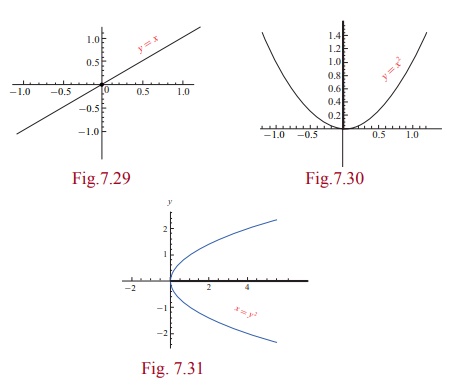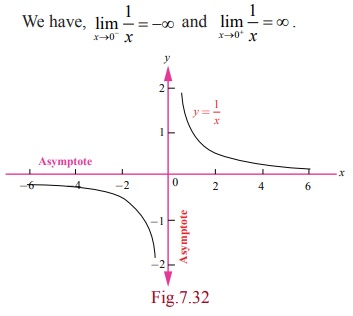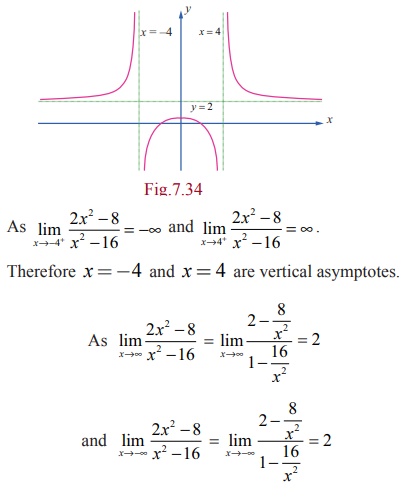Applications of Differential Calculus | Mathematics - Symmetry and Asymptotes | 12th Maths : UNIT 7 : Applications of Differential Calculus
Chapter: 12th Maths : UNIT 7 : Applications of Differential Calculus
Symmetry and Asymptotes
Symmetry and
Asymptotes
Symmetry
Consider
the following curves and observe that each of them is having some special
properties, called symmetry with respect to a point, with respect to a line.

We now
formally define the symmetry as follows :
If an
image or a curve is a mirror reflection of another image with respect to a line,
we say the image or the curve is symmetric with respect to that line. The line
is called the line of symmetry.
A curve
is said to have a ╬Ė
angle rotational symmetry with respect to a point if the curve is unchanged by
a rotation of an angle ╬Ė
with respect to that point.
A curve
may be symmetric with respect to many lines. Specifically, we consider the
symmetry with respect to the co-ordinate axes and symmetric with respect to the
origin. Mathematically, a curve f ( x,
y) = 0 is said to be
ŌĆó Symmetric with respect to the y-axis if f ( x, y ) = f (ŌłÆx , y) ŌłĆ x , y
or if ( x , y) is a point on the graph of the curve then so is (ŌłÆx , y) . If we keep
a mirror on the y-axis the portion of
the curve on one side of the mirror is the same as the portion of the curve on
the other side of the mirror.
ŌĆó Symmetric with respect to the x-axis if f ( x, y ) = f ( x
, ŌłÆ y) ŌłĆx , y or if ( x ,
y) is a point on the graph of the curve then so is ( x , ŌłÆ y)
. If we keep a mirror on the x -axis
the portion of the curve on one side of the mirror is the same as the portion
of the curve on the other side of the mirror.
ŌĆó Symmetric with respect to the
origin if f (
x, y ) = f (ŌłÆx , ŌłÆ y ) ŌłĆx , y or if ( x ,
y) is a point on the graph
of the curve then so is (ŌłÆ x
, ŌłÆ
y) . That is the curve is unchanged
if we rotate it by 180┬░ about the origin.
For
instance, the curves mentioned above x
=
y2 , y = x2 and
y = x
are symmetric with respect to x-axis, y-axis and origin respectively.
Asymptotes
An
asymptote for the curve y =
f ( x) is a straight line which is a tangent at Ōł×
to the curve. In other words the distance between the curve and the straight
line tends to zero when the points on the curve approach infinity. There are
three types of asymptotes. They are
1. Horizontal asymptote, which is parallel to the x -axis. The line y = L is said to be a horizontal asymptote for the curve y = f
(x) if either limxŌåÆ+Ōł× f
(x) = L or limxŌåÆŌłÆŌł× f (x)
= L .
2. Vertical asymptote, which is parallel to the y -axis. The line x = a is said to be vertical asymptote for the curve y = f
(x) if lim xŌåÆaŌłÆ f (x) = ┬▒Ōł× or lim xŌåÆa+ f (x) =┬▒Ōł×.
3. Slant asymptote, A slant (oblique) asymptote occurs
when the polynomial in the numerator is a
higher degree than the polynomial in the denominator.
To find
the slant asymptote you must divide the numerator by the denominator using
either long division or synthetic division.
Example 7.66
Find the
asymptotes of the function f (x) = 1/x.
Solution

Hence, the required vertical asymptote is or the y-axis.
As the
curve is symmetric with respect to both the axes, y = 0 or the x -axis
is also an asymptote. Hence this (rectangular hyperbola) curve has both the
vertical and horizontal asymptotes.
Example 7.67
Find the
slant (oblique) asymptote for the function f
(x) = x2-6x+7 / x+5.

Solution
Since
the polynomial in the numerator is a higher degree (2nd) than the denominator
(1st), we know we have a slant asymptote. To find it, we must divide the numerator
by the denominator. We can use long division to do that:

Notice
that we don't need to finish the long division problem to find the remainder.
We only need the terms that will make up the equation of the line. The slant
asymptote is y =
x ŌłÆ11.
As you
can see in this graph of the function, the curve approaches the slant asymptote
y = x ŌłÆ11
but never crosses it:
Example 7.68
Find the
asymptotes of the curve

Solution

Therefore,
y = 2 is a horizontal asymptote. This
can also be obtained by synthetic division.
Related Topics